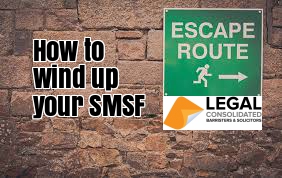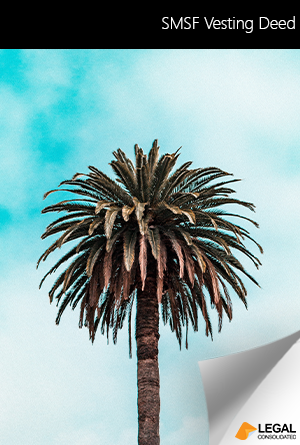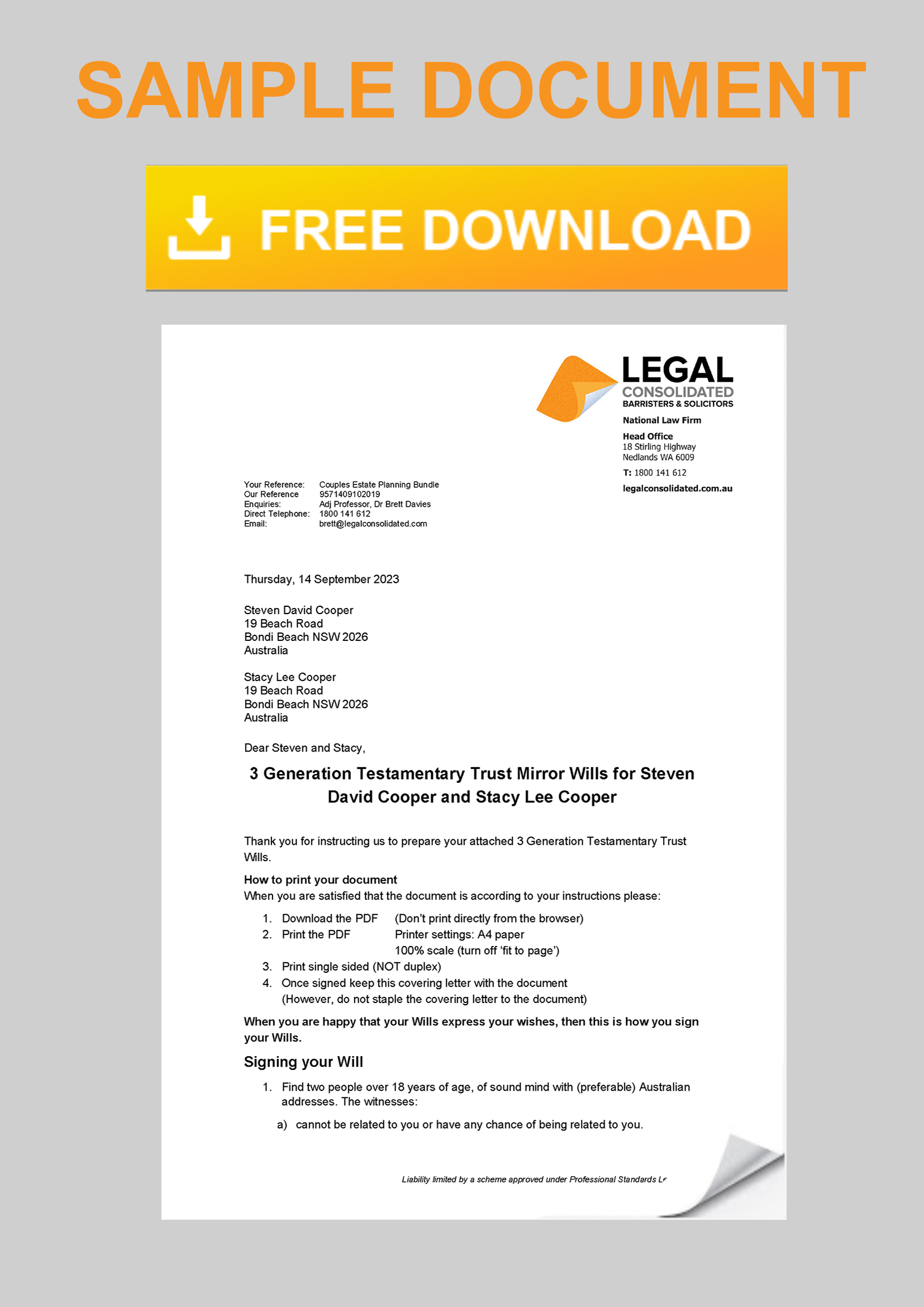Self-Managed Super Fund Vesting Deed – wind up your Self-Managed Super Fund
Do you no longer want to keep your SMSF? If so, build this SMSF winding-up kit. It allows you to end and wind up your Self-Managed Superannuation Fund legally.
Build this SMSF Vesting Deed. It formally winds up (vests) your Self-Managed Super Fund.
Our SMSF Vesting Kit allows you to move from your existing SMSF to a retail public offer fund.
I do not want my SMSF anymore
SMSFs are an excellent way of keeping control and investing in a tax-friendly environment. But they are a lot of work. Perhaps you feel that managing a superannuation fund is a strain on your time, or maybe you are dead.
Over 16,000 SMSFs are wound up each year in Australia.
Nine reasons to wind up the SMSF
Talk with your accountant and financial planner about whether you should get rid of your SMSF:
- The relationship between the up to xis members or directors has changed – fighting, divorced or dead
- You no longer have the time or interest to run the SMSF – working or travelling
- The fund’s investments are managed more effectively and cheaply with a public offer fund – cost
- Your circumstances have changed, which affects your capacity to manage the SMSF – sick, dementia
- The laws and regulations governing SMSFs are too complex, and the effective management of the SMSF investments requires time and expertise, which the trustees do not have or have lost interest in.
- All the members and trustees have left the SMSF, or want to leave – transferred their benefits to another fund or dead
- The SMSF has paid the members all of their benefits
- One or more of the SMSF trustees have moved overseas – no longer a ‘resident regulated superannuation fund’
- Not enough money left in the SMSF to make it viable
Two alternatives to winding up an SMSF:
- Appointing a Legal Personal Representative as Trustee.
- Converting to a ‘small APRA Fund. This is rarely done. This is because these professional trustee companies are expensive and show little flexibility. They often liquidate your property, sell your artwork and buy a balanced share portfolio. You might as well have wound up your SMSF and allowed a much cheaper retail super fund to look after your superannuation.
SMSF Deeds go out of date every 5 – 7 years
There have been many changes over the past few years. You have to update your SMSF Deed regularly:
| 1. Everything – Update Trustee, Upgrade Deed, Binding Nomination and PDS (Recommended) | |
| 2. Trustee only | |
| 3. Upgrade Deed only | |
| 4. Binding Nomination only – updates SMSF Deed as well | |
| 5. Product Disclosure Statement only – fully compliant with the Commonwealth budget measures |
How to terminate the SMSF
1. You payout or roll over the balance of the members’ super to another fund. This may involve selling SMSF assets.
2. A final audit is completed before you lodge the last SMSF annual return. Remember to indicate the SMSF is now wound up.
3. You pay outstanding taxes and other debts. This is before you close your SMSF’s bank account.
4. All the members pass a resolution. We provide this as part of the SMSF vesting kit. It states that the SMSF is to be vested (terminated).
5. The final accounts of the SMSF are prepared.
6. Build our Deed of SMSF Vesting. This vests and closes the Self Managed Super Fund.
7. Notify the ATO within 28 days stating: SMSF Name, ABN, contact person, and date wound up. Send this information to ATO, Post Office Box 3578, ALBURY NSW 2640. (The ATO cancels your ABN for you.)
SMSFs vs Public offer superannuation funds
Different rules apply to public offer super funds compared with the more private SMSF. Only up to 6 people can be in an SMSF. In contrast, a public offer fund can have 1,000s of members.
Four differences between an SMSF and a Public Offer fund:
1. With a public fund, someone else is responsible
-
-
- When investing in a public offer superannuation fund, your superannuation account is one of many.
- This is under the one tax entity. Trustees professionally manage it. This complies with superannuation and taxation law. You are not responsible for the prudential regulations.
- In contrast, in an SMSF, you are the trustee:
- You are responsible for how the fund works.
- You ensure that proper records are kept.
- You are responsible for whether the SMSF is compliant.
- This is in response to the many ever-changing laws and regulations.
- The members are responsible for updating the complying investment strategy.
- You deal with the legal and tax issues.
- When investing in a public offer superannuation fund, your superannuation account is one of many.
-
2. SMSF has to do its own tax return, audit and investment valuations
Public offer funds take care of all your tax returns, audits, ATO audits and investment valuations. Forget about staying up to date with complex superannuation laws and legislation.
You escape the paperwork.
3. Better protection from mistakes in a Public Offer Fund
In a public offer fund, you have greater protection when something goes wrong. Since SMSFs are responsible for their mistakes, they do not get this protection.
SMSFs get no compensation if an SMSF member suffers losses. This is for fraud or theft.
What about complaints and disputes? SMSF members resolve their own issues. This is expensive. There is no access to the Australian Financial Complaints Authority.
4. More choice of investments in an SMSF? Perhaps not…
In an SMSF, you can invest in Bitcoin, racing cars, artworks, cigars and homes that you will move into when you retire. Sure.
Public Offer funds do not have that choice. But few SMSFs invest in such exotics.
There are many Public Offer funds in Australia. They all provide a range of different services and opportunities for your super. That is a lot of choice in itself.
Many public offer funds provide a menu of investment options. You choose the asset class and the percentage of your super you wish to invest in. And the Public Offer funds often set out the risk-return profiles for each asset class.
You get many choices. These may include direct Australian Securities Exchange-listed shares, overseas shares, term deposits, exchange-traded funds, stocks and managed funds.
Build your SMSF Winding up Deed online. It includes:
- Letter of Advice on the law firm’s letterhead – setting out what you need to do to vest your SMSF
- Deed of Variation to your SMSF. It ensures that your SMSF Deed now allows the vesting to take place
- Minutes of SMSF Vesting
- A certificate confirming the Vesting of the SMSF
Even though the SMSF is wound up, keep all documents for 10 years
Even though your SMSF is wound up, you still retain these records for a minimum of 10 years:
- minutes of meetings regarding the fund
- notices of the change of trustees or directors of the corporate trustee, and consents to be SMSF trustees
- copies of member and beneficiary reports.
Also, keep your financial statements for 7 years.
The process to wind up and transfer an SMSF
The nine steps to wind up an SMSF:
1. Build the SMSF vesting kit
The SMSF vesting kit amends your SMSF Deed. This is so you can complete and finish your SMSF in compliance with ATO and ASIC compliance. The kit sets out the procedure. Just press “Start Building” to start building the kit.
2. Written agreement and minutes to wind up the SMSF
All trustees or directors agree about the windup. All the members and the Trustee sign the Minutes provided.
3. Pay existing member benefits
You pay out or roll over the balance of members’ SMSF superannuation to the Public Offer fund. Talk with your accountant and financial planner about selling assets and transferring SMSF assets. Consider selling the SMSF assets to a member. This may be an in-specie transfer. Such sales of SMSF assets must be done at a full and fair price.
4. Prepare draft financial statements
Your accountant prepares the final financial statements. They determine the value of each member’s benefits.
You transfer out the assets. Public Offer funds may be reluctant to take over your shares. They may wish you to convert the shares to cash. And only transfer (rollover) the money to the Public Offer fund.
Pay all expenses.
Any minor amounts of money left over can be transferred to the Public Office fund.
6. Final accounts and audit
Your accountant prepares a final set of accounts. The audit is completed. Your accountant then lodges the final SMSF annual return. Our SMSF Vesting Kit gives your accountant further advice and support for this.
7. Tax and compliance
Pay outstanding taxes and other debts. And close the SMSF bank account.
8. Notify the ATO that you have closed the SMSF
Notify the ATO in writing. This is within 28 days of the SMSF being wound up. You provide to the ATO:
-
-
- SMSF name
- Australian Business Number (ABN)
- date your fund was wound up
- person of contact.
-
9. Get rid of the Company as trustee of your SMSF
Your SMSF either has all members as trustees. Or they have a company as trustee of the SMSF. This is called a “corporate trustee”. It is generally a “Special Purpose Company“. Most SMSFs have a company as trustee.
Either:
-
-
- convert your company to a ‘normal’ company – so it is no longer a Special Purpose Company. And you can use the company for other purposes, or
- Get your accountant or financial planner to wind up the Company with ASIC (voluntary deregistration)
-
Tax implications when closing an SMSF
There may be GST, CGT, transfer (stamp) duty and other tax liabilities. Your accountant and financial planner may be able to reduce such taxes and imposts.
To wind up your SMSF, the SMSF assets are sold. Or at least they are ‘disposed’ of for CGT purposes. This is achieved in 3 ways:
- sell assets to a member
- sell assets to the public
- transfer to the Public Office fund (not common)
Irrespective of how your SMSF disposes of its assets, the SMSF has to pay CGT on the increased value of the asset. The tax impact of this CGT event depends on whether or not the SMSF is paying retirement phase pensions and whether there are any carried-forward capital losses.
- If you are in the ‘accumulation phase’, then there is often a 15% tax on the capital gains (increased value) when you transfer them out of the SMSF. This may drop to 10% if you hold the asset for over 12 months.
- However, being in the pension phase does not mean you automatically escape these taxes.
In-specie transfer of assets to a member
Provided it is in the SMSF’s best interest to do so, and the sale (or transfer if in the pension phase) is at fair market value, the SMSF can sell (or transfer) its assets to the members. Your accountant and financial planner arrange the valuation BEFORE the sale (transfer) takes place. The SMSF auditor examines that valuation.
This is a CGT event. There may also be a transfer (stamp) duty in the relevant Australian State or Territory.
Can SMSF losses be carried over from the SMSF to the Public Offer fund?
Legal Consolidated provides no legal advice. However, generally, losses cannot be carried over. Consider using both revenue and capital losses in the SMSF winding-up process. They are lost when the SMSF is wound up.
Start closing your SMSF well before the end of the financial year
Try to close your SMSF well before the end of the financial year.
This is because if your closing process crosses over into a new financial year, you need another SMSF tax return and audit.
I should never have set up an SMSF, to begin with – escape from your SMSF
Q: My question is, how can I go about closing down my SMSF, and can you help with that?
I try reaching out to the people who convinced me to open it up, but I feel they are not interested in helping me.
A: Self-Managed Superannuation Funds are like one-day-old babies. They need a lot of love and attention. They are time-consuming and expensive.
It seems that you may not have done sufficient homework before you started your SMSF. Here is a free training course on setting up an SMSF.
There are strict rules for winding up a Self-Managed Superannuation Fund and then rolling over the superannuation to another fund.
This SMSF vesting kit takes you through the process.
What does my accountant need to do to end my SMSF?
Your accountant needs to prepare a balance sheet to show that the SMSF has no funds left in it. And you need an auditor to do the last audit of the SMSF. You have a journey ahead of you.
What do I need to do to terminate the SMSF?
- The capital of the trust must be distributed under the trust deed.
- The Trustee satisfies any existing liabilities of the trust. This includes any existing or future tax liabilities that arise as a result of the termination of the SMSF.
- The Trustee passes a resolution determining that the trust is to be vested (terminated).
- The final accounts of the trust, including a final tax return, are prepared.
Once this is done, you build our Deed of Vesting of an SMSF. You get a set of documents that allows you to vest and close the SMSF.
After building this document on our website, you are immediately emailed:
- SMSF Deed of Variation of Vesting
- Minutes
- Letter of advice
Why should I wind up the SMSF?

For many trustees, the work of managing a Self-Managed Super Fund (SMSF) can eventually outweigh the benefits.
The complex regulations, time-consuming paperwork, or a simple change in life circumstances (like retirement, divorce, or members moving overseas) are all common reasons to wind up a fund.
Saying ‘goodbye’ to your SMSF is a formal legal process known as ‘vesting’. This final step legally terminates the trust. It involves paying out or rolling over all member benefits, completing a final audit and tax return for the ATO, and signing a formal SMSF Vesting Deed.
This deed is the essential legal document that confirms the fund is officially and permanently closed.
- The Trust has achieved its original purpose
- It has no assets
- The controllers of the trust do not want to continue
- The trust has reached its vesting date
To vest your SMSF, we identify it. We do this by referring to:
- the SMSF Trust name (e.g. Jones SMSF)
- date the SMSF Deed, which established the Self-Managed Superannuation Fund, was signed
Every trust has a name. Sadly, they are generally quite boring. E.g. Smith SMSF, named after Mr Smith.
The SMSF name is a ‘nickname’. It is not registered anywhere. It just helps you and your accountant identify your SMSF.
Take out your Deed of Trust that first started your SMSF. Have a look at the front cover; it will generally have the name of your SMSF. It is repeated in the body of the Deed as well. Check any subsequent Deeds of Variation to make sure that your SMSF didn’t change its name.
Why get rid of an SMSF that has no assets in it
Leaving an SMSF open with no assets is a common but dangerous mistake. The notion that you should keep old SMSFs, Family Trusts, or Unit Trusts ‘just in case’ you need them later is a costly error. The ATO and Centrelink do not consider the superannuation fund “dormant.” The fund’s legal existence, not its bank balance, is what triggers ongoing, costly obligations for trustees.
Failing to wind up the empty SMSF formally exposes trustees personally to severe financial risks with both the ATO and Centrelink.
Leaving a zero-balance SMSF “dormant” is not an option. It exposes you to thousands in personal penalties and can jeopardise your pension.
The only way to stop these annual costs and legal risks is to wind up the SMSF formally. This process requires a final audit, a final SAR, and a legal SMSF Vesting Deed (also called a Deed of Wind Up) to finalise the trust and notify the ATO that it has ceased to exist.
Why the ATO punishes SMSFs with no assets: Personal Penalties and Ongoing Costs
As long as your SMSF is registered, you are personally liable for its compliance. If the fund has no money, these costs come directly out of your own pocket, which may itself breach SIS Regulations.

Leaving an SMSF open with no assets is a dangerous mistake.
Many people think they should keep SMSFs “just in case” they want to use them again.
The ATO and Centrelink do not consider these funds “dormant.” Their legal existence, not their balance, triggers ongoing and costly trustee obligations.
An empty SMSF still attracts the ATO Supervisory Levy, audit costs, and reporting duties each year.
Centrelink often questions empty SMSFs. It asks how this happened and whether the withdrawals were genuine or designed to access the Age Pension.
To stop the costs and legal risks, formally wind up the SMSF with a legal SMSF Vesting Deed.
-
Annual Supervisory Levy: You must pay the ATO’s Supervisory Levy every year the fund exists. This is a personal debt if the fund cannot pay, and paying the fee out of your own pocket may breach SIS Regulations.
-
Mandatory Annual Audits: Your accountant is still legally required to arrange an external auditor, and you must pay for a full SMSF audit each financial year, even if there is a zero balance and no transactions.
-
Personal Penalties: This is the greatest risk. The ATO issues administrative penalties directly to trustees (not the fund) for non-compliance.
-
Failing to prepare financial statements or accounts.
-
Failing to lodge the SMSF Annual Return (SAR).
-
This is in addition to standard Failure to Lodge (FTL) penalties.
-
- Higher chance of an Audit: Reports from the 4,600 financial planners, accountants, and lawyers who build documents on our website indicate that an empty SMSF is more likely to be audited, not less. The ATO’s systems apparently flag these zero-balance funds as a ‘novelty’ or anomaly. This unusual status often triggers scrutiny, as it may show a failure to lodge a final return or other unresolved compliance issues.
Empty SMSFs risk your Age Pension from Centrelink
We have seen situations where Centrelink wants to understand why you have no assets in an SMSF. It considers it not usual.
How your fund became empty is critical for Centrelink, even if it has been without assets for many years. If you emptied the fund by giving money to family or friends to qualify for the Age Pension, you risk being caught by the “deprivation” (gifting) rules.
-
Gifting Limits: You are only allowed to gift $10,000 per financial year, and no more than $30,000 over a rolling 5-year period.
-
The ‘Phantom Asset’ Trap: If you withdraw $400,000 from your super and give it to your children, Centrelink will subtract the $10,000 allowance and treat the remaining $390,000 as your asset for the next five years.
-
This “deprived asset” is deemed to earn income and will almost certainly make you ineligible for the Age Pension, even though you no longer have the money.
Summary to wind up a Self-Managed Superannuation Fund
Winding up (also known as vesting and ending) a self-managed superannuation fund involves:
- Build the Legal Consolidated Wind-up an SMSF Kit.
- All Members Must Agree: All members of the SMSF must agree to wind up the fund. This decision needs to be documented in writing via a Deed.
- Deal with the Fund’s Assets: Sell or transfer all the SMSF’s assets. This means converting all investments into cash or transferring them to another super fund, and paying out or rolling over all super benefits to the members.
- Finalise Tax Obligations: Ensure that all of the SMSF’s tax and audit obligations are up-to-date. This includes lodging a final tax return and audit report with the Australian Taxation Office (ATO).
- Pay Out or Roll Over All Benefits: Members must either roll their benefits into another superannuation fund or withdraw them if they meet a condition of release.
- Close the Bank Account: After all liabilities have been settled and all assets have been distributed, close the SMSF’s bank account.
- Lodge Final Documents with the ATO: Notify the ATO that the SMSF has been wound up by lodging all required final documents, including a final audit and final annual return. The ATO also needs to be informed once the fund’s bank account is closed.
- Keep Records: Keep all records about the SMSF and its winding up for at least five years after the fund’s final year of operation.
- Sign the Legal Consolidated Deed to End the SMSF.
- Sign the Legal Consolidated prepared minutes.
Free Centrelink toolkit
These free resources empower you on how to deal with Centrelink:
- Remove a Centrelink person from your Family Trust
- Centrelink attacking innocent grandparents – what we do for our children
- Wind up Family Trusts
- Replacing the Appointor in a Family Trust – succession planning for a person wanting Centrelink
- Company to replace pensioner as trustee of a Family Trust
- Wind-up Unit Trusts
- Can beneficiaries disclaim a trust distribution?
- Loans to parents – not means tested by Centrelink
- What to do before the end of each financial year – to appease Centrelink
- Centrelink compliant Power of Attorney – keeps your family in control, not Centrelink
- 3-Generation Testamentary Trust Wills – beneficiaries retain Centrelink benefits in your Will
- Special Disability Trust – to escape Centrelink deprivation rules
Alternative structures to superannuation
Family trust v Superannuation
- Family Trust Deed – watch the free training course
- Get rid of an old Family Trust
Unit trust v Superannuation
- Unit Trust
- Unit Trust Vesting Deed – wind up your Unit Trust
- Change Unit Trust Trustee – replace the trustee of your Unit Trust
Using business structures rather than a Self-Managed Superannuation Fund
- Partnership Agreement – but what about joint liability?
- Incorporate an Australian Company – best practice with the Constitution
- Upgrade the old Company Constitution – this is why
- Replace lost Company Constitution – about to get an ATO Audit?

